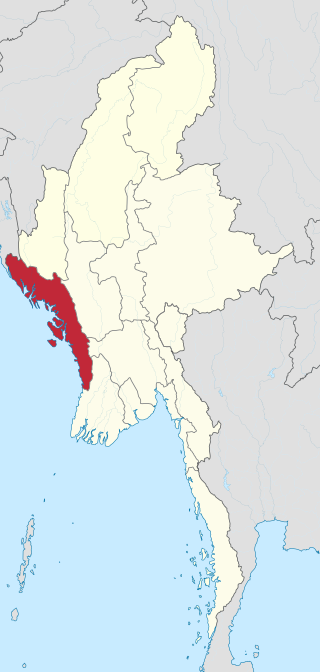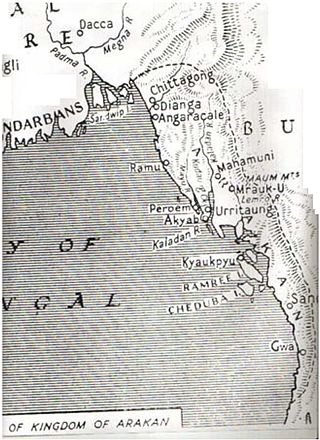Related Research Articles

Rakhine State, formerly known as Arakan State, is a state in Myanmar (Burma). Situated on the western coast, it is bordered by Chin State to the north, Magway Region, Bago Region and Ayeyarwady Region to the east, the Bay of Bengal to the west and the Chittagong Division of Bangladesh to the northwest. It is located approximately between latitudes 17°30' north and 21°30' north and longitudes 92°10' east and 94°50' east. The Arakan Mountains or Rakhine Yoma separated Rakhine State from central Burma from North to South. Off the coast of Rakhine State there are some fairly large islands such as Ramree, Cheduba and Myingun. Rakhine State has an area of 36,762 square kilometres (14,194 sq mi) and its capital is Sittwe.

Sittwe , formerly Akyab (အာကျပ်), is the capital of Rakhine State, Myanmar (Burma). Sittwe is located on an estuarial island created at the confluence of the Kaladan, Mayu, and Lay Mro rivers emptying into the Bay of Bengal. As of 2019 the city has an estimated population of over 120,000 inhabitants. It is the administrative seat of Sittwe Township and Sittwe District.

The Rohingya people are a stateless ethnic group who predominantly follow Islam and reside in Rakhine State, Myanmar. Before the Rohingya genocide in 2017, when over 740,000 fled to Bangladesh, an estimated 1.4 million Rohingya lived in Myanmar. Described by journalists and news outlets as one of the most persecuted minorities in the world, the Rohingya are denied citizenship under the 1982 Myanmar nationality law. There are also restrictions on their freedom of movement, access to state education and civil service jobs. The legal conditions faced by the Rohingya in Myanmar have been compared to apartheid by some academics, analysts and political figures, including Nobel laureate Bishop Desmond Tutu, a South African anti-apartheid activist. The most recent mass displacement of Rohingya in 2017 led the International Criminal Court to investigate crimes against humanity, and the International Court of Justice to investigate genocide.

The Rakhine People or Arakanese are a Southeast Asian ethnic group in Myanmar (Burma) forming the majority along the coastal region of present-day Rakhine State, although Rakhine communities also exist throughout the country, particularly in the Ayeyarwady and Yangon Regions. They constitute approximately 4.61% or more of Myanmar's total population. Rakhine communities exist in Bangladesh's Chittagong Hill Tracts and in India, where they are known as the Marma and Mog peoples respectively.

Islam is a minority religion in Myanmar, practised by about 2.1% of the population, according to the 2014 Myanmar official statistics.
There is a history of persecution of Muslims in Myanmar that continues to the present day. Myanmar is a Buddhist majority country, with significant Christian and Muslim minorities. While Muslims served in the government of Prime Minister U Nu (1948–63), the situation changed with the 1962 Burmese coup d'état. While a few continued to serve, most Christians and Muslims were excluded from positions in the government and army. In 1982, the government introduced regulations that denied citizenship to anyone who could not prove Burmese ancestry from before 1823. This disenfranchised many Muslims in Myanmar, even though they had lived in Myanmar for several generations.

Rakhine State occupies the northern coastline of Myanmar up to the border with Bangladesh and corresponds to the historical Kingdom of Arakan. The history of Rakhine is divided into 7 parts - the independent kingdoms of Dhanyawadi, Waithali, Lemro, Mrauk U, Burmese occupation from 1785 to 1826, British rule from 1826 to 1948 and as a part of independent Burma from 1948.

The Kingdom of Mrauk-U was a kingdom that existed on the Arakan littoral from 1429 to 1785. Based in the capital Mrauk-U, near the eastern coast of the Bay of Bengal, the kingdom ruled over what is now Rakhine State, Myanmar and southern part of Chittagong Division, Bangladesh. Though started out as a protectorate of the Bengal Sultanate from 1429 to 1531, Mrauk-U went on to conquer Chittagong with the help of the Portuguese. It twice fended off the Toungoo Burma's attempts to conquer the kingdom in 1546–1547, and 1580–1581. At its height of power, it briefly controlled the Bay of Bengal coastline from the Sundarbans to the Gulf of Martaban from 1599 to 1603. In 1666, it lost control of Chittagong after a war with the Mughal Empire. Its reign continued until 1785, when it was conquered by the Konbaung dynasty of Burma.
The 2012 Rakhine State riots were a series of conflicts primarily between ethnic Rakhine Buddhists and Rohingya Muslims in northern Rakhine State, Myanmar, though by October Muslims of all ethnicities had begun to be targeted. The riots started came after weeks of sectarian disputes including a gang rape and murder of a Rakhine woman which police allege was committed by three Rohingya Muslims. On 8 June 2012, Rohingyas started to protest from Friday's prayers in Maungdaw township. More than a dozen residents were killed after police started firing. A state of emergency was declared in Rakhine, allowing the military to participate in administration of the region. As of 22 August 2012, officially there were 88 casualties: 57 Muslims and 31 Buddhists. An estimated 90,000 people were displaced by the violence. Around 2,528 houses were burned; of those, 1,336 belonged to Rohingyas and 1,192 belonged to Rakhines.

The Rohingya conflict is an ongoing conflict in the northern part of Myanmar's Rakhine State, characterised by sectarian violence between the Rohingya Muslim and Rakhine Buddhist communities, a military crackdown on Rohingya civilians by Myanmar's security forces, and militant attacks by Rohingya insurgents in Buthidaung, Maungdaw, and Rathedaung Townships, which border Bangladesh.

The Arakan Army, sometimes referred to as the Arakha Army, is an ethno-nationalist armed organisation based in Rakhine State (Arakan). Founded in April 2009, the AA is the military wing of the United League of Arakan (ULA). It is currently led by Commander-in-Chief Major General Twan Mrat Naing and vice deputy commander-in-chief Brigadier General Nyo Twan Awng. The Arakan Army states that the objective of its armed revolution is to restore the sovereignty of the Arakan people. It was declared a terrorist organization in 2020 by Myanmar, and again by the State Administration Council junta in 2024.

The Arakan Rohingya Salvation Army (ARSA), formerly known as Harakah al-Yaqin, is a Rohingya insurgent group active in northern Rakhine State, Myanmar. According to a December 2016 report by the International Crisis Group, it is led by Ataullah abu Ammar Jununi, a Rohingya man who was born in Karachi, Pakistan, and grew up in Mecca, Saudi Arabia. Other members of its leadership include a committee of Rohingya émigrés in Saudi Arabia.
The following lists events in the year 2017 in Myanmar.

The Rohingya genocide is a series of ongoing persecutions and killings of the Muslim Rohingya people by the military of Myanmar. The genocide has consisted of two phases to date: the first was a military crackdown that occurred from October 2016 to January 2017, and the second has been occurring since August 2017. The crisis forced over a million Rohingya to flee to other countries. Most fled to Bangladesh, resulting in the creation of the world's largest refugee camp, while others escaped to India, Thailand, Malaysia, and other parts of South and Southeast Asia, where they continue to face persecution. Many other countries consider these events ethnic cleansing.

Violent clashes have been ongoing in the northern part of Myanmar's Rakhine State since October 2016. Insurgent attacks by the Arakan Rohingya Salvation Army (ARSA) have led to sectarian violence perpetrated by Myanmar's military and the local Buddhist population against predominantly Muslim Rohingya civilians. The conflict has sparked international outcry and was described as an ethnic cleansing by the United Nations High Commissioner for Human Rights. In August 2017, the situation worsened and hundreds of thousands of refugees fled Myanmar into Bangladesh, with an estimated 500,000 refugees having arrived by 27 September 2017. In January 2019, Arakan Army insurgents raided border police posts in Buthidaung Township, joining the conflict and beginning their military campaign in northern Rakhine State against the Burmese military.
Sultan Mahmud (1900–1982) was a politician from Arakan, Burma. In the British Raj, Mahmud served as cabinet secretary in the Central Legislative Assembly. After Burmese independence, he was elected to the Parliament of Burma through a by election from Buthidaung in 1957. He was re-elected in 1960. He served as Minister of Health of the Union of Burma from 1960 till the 1962 Burmese coup d'état.

Arakan is the historical geographical name of Rakhine State, Myanmar. The region was called Arakan for centuries until the Burmese military junta changed its name in 1989. The people of the region were known as Arakanese.

On 25 August 2017, Hindu villages in a cluster known as Kha Maung Seik in the northern Maungdaw District of Rakhine State in Myanmar were attacked and 99 Bengali Hindu villagers were massacred by Muslim insurgents from the Arakan Rohingya Salvation Army (ARSA). A month later, the Myanmar Army discovered mass graves containing the corpses of 45 Hindus, most of whom were women and children.
The Chut Pyin massacre was a massacre of Rohingyas by the Myanmar Army and armed Rakhine locals that purportedly took place in the village of Chut Pyin, in Rakhine State, Myanmar on 25 August 2017, the same day Arakan Rohingya Salvation Army (ARSA) insurgents attacked security forces along the Bangladesh–Myanmar border. The event was first brought to attention after a report was published by Human Rights Watch, which detailed accounts of rape and killings from survivors.

Jacques Pierre Leider is a French and Luxembourgian historian, teacher and former diplomat.
References
- ↑ "Racism to Rohingya in Burma" (PDF). Burma Library. Retrieved 29 June 2023.
- 1 2 Field-Marshal Viscount William Slim (2009). Defeat Into Victory: Battling Japan in Burma and India, 1942–1945. London: Pan. ISBN 978-0330509978.
- ↑ Christie, Clive J. (1998). A Modern History of Southeast Asia: Decolonization, Nationalism and Separatism. I.B. Tauris. pp. 164, 165–167. ISBN 9781860643545.
- ↑ Yegar, Moshe (2002). Between Integration and Secession: The Muslim Communities of the Southern Philippines, Southern Thailand, and Western Burma/Myanmar. Lexington Books. pp. 33–35. ISBN 9780739103562.
- 1 2 Chan (Kanda University of International Studies), Aye (Autumn 2005). "The Development of a Muslim Enclave in Arakan (Rakhine) State of Burma (Myanmar)" (PDF). SOAS Bulletin of Burma Research . 3 (2): 396–420. ISSN 1479-8484. Archived from the original (PDF) on 12 July 2013. Retrieved 3 July 2013.
- ↑ Kyaw Zan Tha, MA (July 2008). "Background of Rohingya Problem": 1.
{{cite journal}}: Cite journal requires|journal=(help) - ↑ The Muslim massacre of 1942 Archived 2017-09-13 at the Wayback Machine
- ↑ Kurt Jonassohn (1999). Genocide and gross human rights violations: in comparative perspective. Transaction Publishers. p. 263. ISBN 978-0765804174 . Retrieved 12 April 2011.
- ↑ Howard Adelman (2008). Protracted displacement in Asia: no place to call home. Ashgate Publishing, Ltd. p. 86. ISBN 978-0754672388 . Retrieved 12 April 2011.
- ↑ Human Rights Watch (Organization) (2000). Burma/Bangladesh: Burmese refugees in Bangladesh: still no durable solution. Human Rights Watch. p. 6. Retrieved 12 April 2011.
- ↑ Asian profile, Volume 21. Asian Research Service. 1993. p. 312. Retrieved 12 April 2011.